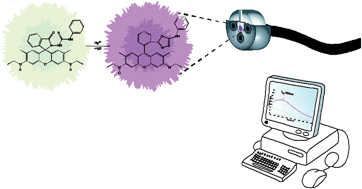Hg2+-selective sensing film based on the incorporation of a rhodamine 6G derivative into a novel hydrophilic water-insoluble copolymer†
Abstract
We describe a Hg2+-selective sensing film based on the incorporation of a spirocyclic phenylthiosemicarbazide rhodamine 6G derivative (called FC1) into a novel hydrophilic water-insoluble copolymer synthesized by Reverse Atom Transfer Radical Polymerization. It is demonstrated that the chemodosimeter preserves its sensing ability and displays intense fluorescence in the presence of mercury(II) after being immobilized in the novel MMA-co-HEMA water insoluble linear copolymer containing 29.6% HEMA. This paper describes the synthesis and characterization of the MMA-co-HEMA copolymer, and the careful optimization of all the instrumental and experimental variables which can affect the sensitivity of the sensing film. It responds to Hg2+ concentrations in water between 0.9 and 12 μM, with a detection limit of 0.3 μM Hg2+ and the response is highly selective to Hg2+ and methylmercury. The applicability of the sensing film has been demonstrated by analysing two real samples (tap and mineral waters) obtaining recovery percentages close to 100% with RSD lower than 5%.


 Please wait while we load your content...
Please wait while we load your content...